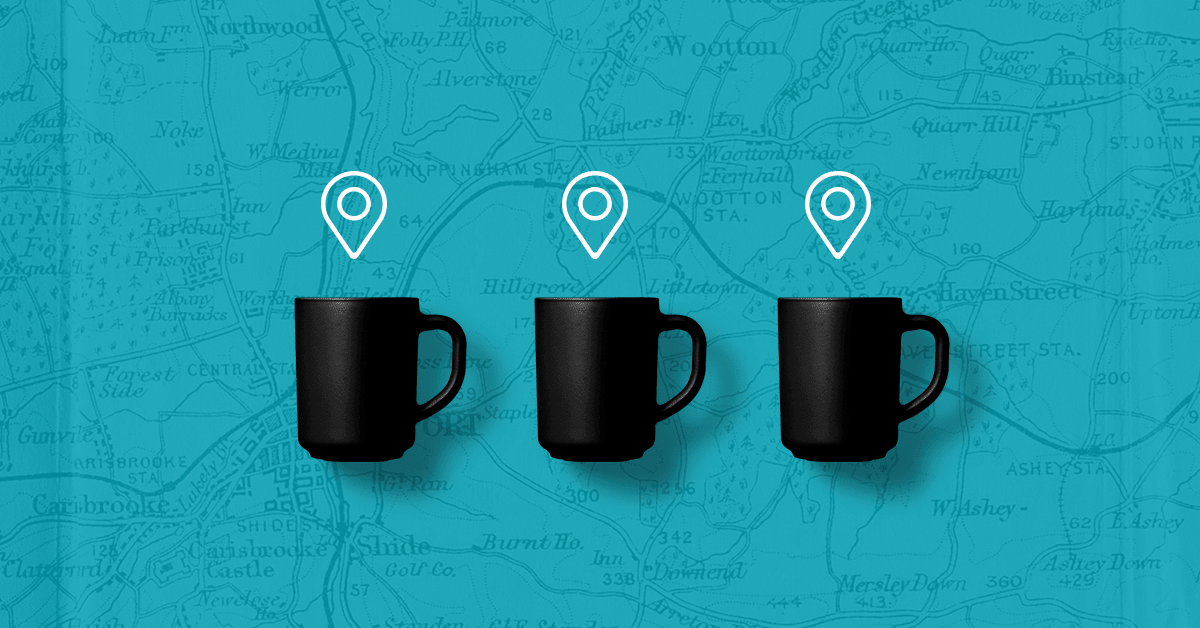Hello!
Despite setbacks from the pandemic, sales projections are looking up for the restaurant industry. By the end of 2024, sales are projected to hit $1 trillion, with an anticipated increase of 200,000 jobs in the industry. For restaurant owners aiming to expand, this presents an ideal opportunity to consider opening a new location.
 Although opening a new location offers a significant growth opportunity for restaurant brands, it also involves considerable risks. If your business is not adequately prepared, opening another location could set you back.
Although opening a new location offers a significant growth opportunity for restaurant brands, it also involves considerable risks. If your business is not adequately prepared, opening another location could set you back.
The key to restaurant growth is a solid multi-location marketing strategy. This strategic marketing approach is all about helping your restaurants expand their reach and engagement, ensuring your new location will be a success.
This article will serve as a guide for restaurant owners looking to grow. It will cover the basics of multi-location marketing, explain its benefits, and highlight the important steps you need to implement to develop the right marketing strategy for expansion.
We’ll also address important touchpoints to help you make a good first impression with a new location, and offer tips on other ways to grow your business without breaking the bank.
Understanding Multi-Location Marketing and Its Benefits
Multi-location marketing is a specific kind of marketing approach that helps brands tailor their promotional efforts to ensure alignment with customer preferences in a new location.
A marketing strategy that works well in one location will not necessarily work well in another. Different neighborhoods, cities, and even different states will have different trends and the demographics in that location can lead to varying preferences.
 For example, how you market your restaurant in a small, laid-back town will likely need to be different than how you market your business in a bigger city.
For example, how you market your restaurant in a small, laid-back town will likely need to be different than how you market your business in a bigger city.
Also, while one location might be in an area with a younger demographic, another location might be near older families, which will also require an adaptive marketing strategy.
This is why it’s important to adopt a multi-location marketing strategy that will consider the different local preferences and ensure the effectiveness of your marketing campaign and business efforts. The key foundations that make this kind of marketing strategy effective are localized content, to be findable, and customer engagement.
The Benefits of Multi-Location Marketing
There are many benefits that come from adopting a multi-location marketing strategy when you are looking to expand your restaurant business, including:
 Improved customer experience: Multi-location marketing requires you to perform research to better understand new customer segments. This can result in more tailored marketing efforts that enhance customer satisfaction.
Improved customer experience: Multi-location marketing requires you to perform research to better understand new customer segments. This can result in more tailored marketing efforts that enhance customer satisfaction.
Increased brand reach: By opening a new location and tailoring your marketing to multiple locations, you increase brand awareness in different regions.
This means more people know about your restaurant, which will help you stay on the top of customer’s minds in different regions.
The opportunity to target new audiences: Not only does multi-location increase your reach, but it also opens you up to new audiences that you might not have been able to target before. If you want to gain a younger audience, for example, opening a new location where there is a younger demographic and tailoring your marketing to their preferences can help you increase diversity in your target audience.
Increase traffic: Local SEO is a major component of multi-location marketing. Google reports show that this kind of marketing drives more traffic to your business as there has been a 150% increase in local searches in recent years.
Increased ROI: Multi-location marketing helps you spend smarter where your marketing budget is concerned. Because you are personalizing and tailoring your marketing to local demographics, your campaigns will be more effective, which means increased revenue and a greater return on your investment.
How to Master Multi-Location Marketing to Help Grow Your Restaurant Business
As a restaurant wanting to open another location or even multiple new locations, you will need to develop a strategy that ensures your brand is established, engaging, findable, and visible in all of your locations — and these are the steps that can help you get there.
1. Establish a Clear Brand Identity
While some of your marketing efforts will need to vary by location depending on the new audience you are catering to, it’s still important to have a cohesive brand image and identity across all locations.
Your brand image and identity include things such as your logo, colors, general design, your voice and style, and your brand's mission and values.
Having a clear, identifiable brand image makes it easier for your customers to recognize your brand and makes for a more memorable brand experience that will help you gain a loyal customer following.
2. Leverage Existing Customer Loyalty
If you already have people who love your restaurant in one location, use their good reviews to help market your new location. Demonstrating to a new audience in a different location that you already have a dedicated customer base will help attract new customers and expand your loyal following.
Highlighting five-star reviews can build trust and enhance your brand's reputation, ultimately boosting your overall credibility. A good brand reputation is key to effective expansion and long-term success.
3. Optimize Your Local SEO
 Local SEO is critical when opening new locations as it ensures your restaurant will be visible in location-based Google search results, which is how most people find businesses today.
Local SEO is critical when opening new locations as it ensures your restaurant will be visible in location-based Google search results, which is how most people find businesses today.
The first step in local SEO is creating a Google Business profile page.
When you have multiple locations, you will need to create separate profiles for each one, as these essentially serve as digital business cards that will help people find you.
Once you have your local profiles, you’ll also want to encourage customers to leave reviews to help increase your visibility and loyal following.
You can also use your Google Business profiles to post updates similar to how you would on social media. Regular updates are important to keep people engaged and aware of what is going on at your restaurant.
Another aspect of local SEO is keyword usage. In your Google profiles, as well as your website and other content, it will be important to use relevant local keywords to improve your search engine rankings and further help people find your restaurant.
For example, if you are an Italian restaurant in Chicago, you could use keywords or keyword phrases like “best Italian food in Chicago.”
You can also consider hiring a well-established agency that can effectively optimize your local SEO, enhance your organic search rankings, and boost your sales.
4. Leverage Local Influencers
 Social media engagement is a critical part of multi-location marketing, and one easy way to do this is by using social media influencers. Foodie influencers are in abundance on social media apps and people love to follow them for their authentic content and honest reviews.
Social media engagement is a critical part of multi-location marketing, and one easy way to do this is by using social media influencers. Foodie influencers are in abundance on social media apps and people love to follow them for their authentic content and honest reviews.
To piggyback on their following and increase your own views and engagement, reach out and invite them to your new location in exchange for an honest review.
The one thing you don’t want to do, however, is bribe them to leave a five-star review. The best influencers are ones who keep things real and authentic with their followers, so they won’t take kindly to being bribed into giving a dishonest review.
Just make sure to give them the best experience possible so they can’t help but leave a good review.
5. Create Location Specific Content
Creating localized website content is another important aspect of local SEO and attracting new local audiences. Localizing your content will help with search results and drive traffic to your website and it will help you personalize your content for specific markets.
Localized content can include local landing pages, for example, with local keywords and other relevant local content, such as contact information, address, direction, services and products offered, and hours of operation.
Landing pagesshould also include headings, title tags, and meta descriptions with local keywords and you can also include a location-specific FAQ section.
In addition to landing pages, you will want to create localized email campaigns for your new restaurant locations. Email campaigns are an excellent method to keep your audience informed about your restaurant and updated on special events or promotions.
You can run a grand opening email campaign, for example, when you are ready to open your new location.
Emails are also useful for following up with customers and asking them to leave you a review. Remember, building up reviews on a new Google business profile page is another important part of local SEO.
6. Utilize Local Ads
With Google, you can create local ad campaigns that increase your visibility in specific locations. You can place ads on Google Search, Google Maps, and your business profile.
 Google's geo-targeting allows you to reach customers in specific areas by showing them ads based on their location (precise location). For example, if you post an ad from your restaurant located in Chicago, you don’t want that ad to be sent to someone who lives near your other location in the next state over.
Google's geo-targeting allows you to reach customers in specific areas by showing them ads based on their location (precise location). For example, if you post an ad from your restaurant located in Chicago, you don’t want that ad to be sent to someone who lives near your other location in the next state over.
Instead, you want your ads to specifically target customers who are near the location you are posting from.
7. Create Personalized, Segmented Content
Segmented content targets audiences based on shared features, behaviors, and characteristics. This can include things like a shared location, demographics, and even shared habits. Creating personalized, segmented content is another critical part of developing an effective multi-location marketing strategy.
When it comes to segmenting audiences, big data can aid your financial decisions as you determine how your marketing funds should be allocated. Essentially, you can use analytics to identify segment demographics, analyze sentiment, and forecast trends.
These insights can then inform your content creation across channels. Instead of a scattershot approach, you’ll know where to allocate funds so you’re not overspending on content.
This improves your return on investment.
The content you create should take into consideration things like neighborhood location, shopping habits, age, and income.
These shared commonalities in certain locations will play a role in the services you offer, the language you use in your marketing content, your tone of voice, messaging recommendations, and even the marketing channels you use.
For example, an older demographic might be more active on Facebook, while a younger demographic will prefer marketing through Instagram or TikTok.
8. Increase Social Media Engagement
Again, social media engagement is vital, as the majority of consumers today are very active on social media and use these apps to obtain the majority of their information about brands.
So when opening a new location, you’ll want to create separate social media accounts for each one.
You’ll also want to engage with local customers on each account by running location-specific social ads and creating location-specific posts.
Users also love it when you engage with them in the comments. Local social media accounts are also useful when you want to run promotions at different locations.
9. Connect With the Local Community
 If you really want to increase your brand awareness and build your reputation in a new location, get involved in the community. Showing that your restaurant cares about being an important part of the community will help you draw in more loyal customers who will regularly book a table to show their support for your business.
If you really want to increase your brand awareness and build your reputation in a new location, get involved in the community. Showing that your restaurant cares about being an important part of the community will help you draw in more loyal customers who will regularly book a table to show their support for your business.
Your restaurant can sponsor local sports teams, attend community events, or even offer up your food and services for soup kitchens and homeless shelters.
There are countless ways to show how your business cares and wants to give back.
10. Automate With the Right Technology
This final step is one that you should consider starting with, which is using the right technology to improve your marketing strategy. When you are dealing with multi-location marketing, things can easily get overwhelming.
From multiple social media accounts and business profiles to separate email campaigns, it’s easy to lose track of what needs to be done. This is why it’s helpful to use automation tools and software to centralize all of your marketing tasks.
Local marketing software makes it easier and more convenient to manage all of your marketing for multiple locations in one place. Many of these software solutions also come with data tracking tools that can help you track the effectiveness of your campaigns and offer you insights into ways you can improve.
Important Touchpoints to Help You Make a Good First Impression
 When opening a new location, first impressions will play an important role in customer loyalty. Things like atmosphere, quality of service and food, communication, and how long it takes to fulfill or deliver a customer’s order are key factors that can impact first impressions and whether a first-time customer will return or leave a good review.
When opening a new location, first impressions will play an important role in customer loyalty. Things like atmosphere, quality of service and food, communication, and how long it takes to fulfill or deliver a customer’s order are key factors that can impact first impressions and whether a first-time customer will return or leave a good review.
Convenience and personalization are also important when opening a new location.
Can customers easily book a table? Can they easily access your website and find the information they need about your food and services?
Does your new location cater to the specific needs of the demographic in this area? These are things that customers will notice when they are checking out a new restaurant.
To ensure a good first impression, these are the essential restaurant touchpoints you should be focusing on:
- A user-friendly, informative, and engaging website
- A user-friendly online reservation platform like OpenTable
- A mobile responsive website and mobile-friendly apps
- An easy-to-read and attractive menu design
- A welcoming atmosphere and pleasing ambiance
- Friendly and knowledgeable staff interactions
- Quality food presentation and plating
- Loyalty and rewards programs
- Post-visit follow-up engagement, such as thank-you emails
- An easy and accessible way for customers to leave reviews
All of these touchpoints are vital as they show the time and effort you have taken to ensure your brand and your restaurant meet your customers’ needs. A good first impression goes a long way when establishing your brand in a new location and building a loyal following.
Other Ways to Expand Your Restaurant Business
If money is tight, but you still want to grow your business there are other strategies you can use to complement your multi-location marketing strategy without a significant upfront investment.
Growing your restaurant business doesn’t mean you have to open a fully operational brick-and-mortar location. Below are some ideas for opening a “second location” without breaking the bank:
A Pop-Up Shop — Opening a more temporary structure for a small pop-up is a great way to test the waters in a new location without fully committing.
This gives you time to see if your restaurant would do well in a new location while you work on saving up the funds to open a more permanent structure.
A Food Truck — Everybody loves food trucks! A restaurant on wheels is another option if you want to try out a new spot to see what business might be like in a certain area. With a food truck, you can also easily move around to test out multiple locations in case one of them doesn’t work out.
A Co-Collaboration — Co-retailing is when two businesses work together and share a space to split the costs. Collaborations like this also create a unique experience for customers. As a restaurant, you could co-retail with another food business or even a bar. You could also share a space with something like an art gallery or a retail store for a really creative and unique experience.
Also read:
- How Site Security Impacts SEO
- 8 Advantages of Implementing a Delivery Service for Your Restaurant
- 5 Types of Google Ranking Drops and How to Deal with Them
In Summary
This is the right time to expand your brand since the restaurant industry is growing. As you develop your multi-location marketing strategy, remember to also stay up-to-date on marketing trends.
While local marketing should be your focus, it’s also important to take advantage of ever-changing marketing trends to stay relevant and appealing to current audiences.
The key thing to remember is that any marketing strategy is not a one-and-done deal. You must always be updating your marketing to keep up with changing trends in customer behaviors, habits, and needs.
Keeping your marketing fresh and current is also an important part of customer engagement and continuing to attract new audiences to grow your loyal following.
Thank you!
Join us on social media!
See you!






